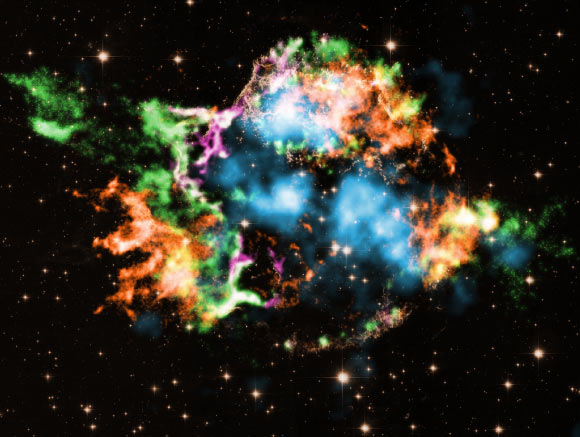Astronomers using NASA’s Chandra X-ray Observatory have detected stable titanium, along with chromium and iron, blasting out from the center of the supernova remnant Cassiopeia A.

This composite image, taken by NASA’s Chandra X-ray Observatory and the NASA/ESA Hubble Space Telescope, shows the supernova remnant Cassiopeia A; the different colors represent elements detected by Chandra: iron (orange), oxygen (purple), and the amount of silicon compared to magnesium (green); titanium (light blue) detected previously by NASA’s NuSTAR telescope is shown, but not the different type of titanium found by Chandra. Image credit: NASA / CXC / RIKEN / Sato et al. / NuSTAR.
Cassiopeia A (Cas A), which is located about 11,000 light-years from Earth, is the most studied nearby supernova remnant.
When the original star ran out of fuel, it collapsed onto itself and blew up as a supernova, possibly briefly becoming one of the brightest objects in the sky.
Although scientists think that this happened around the year 1680, there are no verifiable historical records to confirm this.
Previously astronomers had used NASA’s NuSTAR telescope to discover an unstable isotope of titanium — titanium-44 — in different locations in Cas A.
“Scientists think most of the titanium that is used in our daily lives — such as in electronics or jewelry — is produced in a massive star’s explosion,” said Dr. Toshiki Sato, an astronomer at Rikkyo University.
“However, until now they have never been able to capture the moment just after stable titanium is made.”
When the nuclear power source of a massive star runs out, the center collapses under gravity and forms either a dense stellar core called a neutron star or, less often, a black hole.
When a neutron star is created, the inside of the collapsing massive star bounces off the surface of the stellar core, reversing the implosion.
The heat from this cataclysmic event produces a shock wave that races outwards through the rest of the doomed star, producing new elements by nuclear reactions as it goes.
However, in many computer models of this process, energy is quickly lost and the shock wave’s journey outwards stalls, preventing the supernova explosion.
Recent 3D computer simulations suggest that neutrinos made in the creation of the neutron star play a crucial role in driving bubbles that speed away from the neutron star. These bubbles continue driving the shock wave forward to trigger the supernova explosion.
With the new study of Cas A, Dr. Sato and colleagues discovered powerful evidence for such a neutrino-driven explosion.
In the Chandra data they found that finger-shaped structures pointing away from the explosion site contain titanium and chromium, coinciding with iron debris previously detected with Chandra.
The conditions required for the creation of these elements in nuclear reactions, such as the temperature and density, match those of bubbles in simulations that drive the explosions.
Titanium detected by Chandra in Cas A and predicted by these simulations is a stable isotope of the element.
“We have never seen this signature of titanium bubbles in a supernova remnant before, a result that was only possible with Chandra’s incredibly sharp images,” said Dr. Keiichi Maeda, an astronomer at Kyoto University.
“Our result is an important step in solving the problem of how these stars explode as supernovae.”
“When the supernova happened, titanium fragments were produced deep inside the massive star,” said Dr. Shigehiro Nagataki, an astronomer at the RIKEN Cluster for Pioneering Research.
“The fragments penetrated the surface of the massive star, forming the rim of the supernova remnant, Cas A.”
“Our research could be the most important observational result probing the role of neutrinos in exploding massive stars since the detection of neutrinos from Supernova 1987A,” added Dr. Takashi Yoshida, an astronomer at Kyoto University.
The findings were published in the journal Nature.
_____
T. Sato et al. 2021. High-entropy ejecta plumes in Cassiopeia A from neutrino-driven convection. Nature 592, 537-540; doi: 10.1038/s41586-021-03391-9







